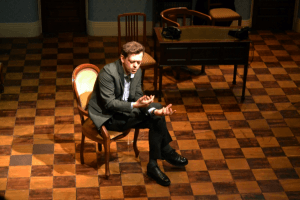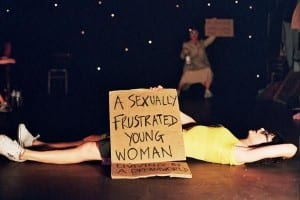The post-dramatic: Playwriting, Scripting, and Devising. (Continued.)
My notes on Simon Stephen’s “Pornography” (2008). With reference from Jacqueline Bolton’s Introduction & commentary in Pornography (2014).

Simon Stephens Master Class post-show discussion, Theatre Royal Haymarket.
“Based upon Jaquez’s ‘Seven Ages of Man’ speech in As You Like It […] the seven scenes of Pornography take the form of four monologues, two duologues and a numbered list offering short descriptions of the 52 people killed in the 7/7 London bombings. The scenes do not constitute a unified plot in which a central narrative, focused upon one protagonist, unfolds chronologically. Instead, we are presented with a crystalline structure in which the first week of July 2005 is refracted through the perspectives of eight anonymous individuals experiencing six different situations. Pornography locates ‘the source and (as it were) the soul’ of the drama in the real-life events– the veridical history – of London during this tumultuous week: on 2 July, the rock concert Live 8 was held in Hyde Park with simultaneous concerts played globally; on 6 July, London was awarded the 2012 Olympic Games; on 7 July, four British-born Muslim Commentary 15 men detonated four bombs across the London transport system. Rather than serving to propel the forward thrust of a singular linear narrative, the characters of Pornography – and the incidents and impressions they narrate and enact – are linked by their proximity to, and fleeting intersections with, a series of localized events with global important” (Bolton, 2014, 14-15.).
“Pornography is a play that dramatizes ‘a world that seems to be more atomized and fractured than it has been in the past’, a world peopled by individuals ‘scorched by a need and an inability to connect’.10 Pornography does not only illustrate the dislocation and disaffection engendered in and by contemporary lived experience, however. In its selection and organization of dramatic, Pornography also invites critical consideration of some of the precipitating causes of a society in moral and ethical disarray: those political, economic and social ‘flaws and ruptures’, the aftershocks of which currently reverberate throughout Western and non-Western cultures alike” (Stephens, cited in Bolton, 2014, 29.).
“An estimated 3 billion people – almost half the world’s population– watched Live 8 through various media platforms, including live streaming on the internet provided by the US-based multinational media corporation AOL Time Warner.24 According to the AOL website, feeds from London, Philadelphia and other capitals around the world reached a total of 5 million unique users that day, making it the largest streaming event ever. The event also spawned more than 26 million text messages – the largest number of text messages sent on one day25” (Time Warner Cited In. Bolton, 2014, 36.).
“It seems significant, moreover, that the journey recounted by the suicide bomber in Scene Four is not an authentic account of the route taken by the four men that day but instead describes a journey from Manchester, via Stoke and Derby, to London King’s Cross St Pancras.4 This is, in fact, the reverse route of a journey that Stephens himself once took from London to his brother’s house in Derby, and on to his Mum’s house in Stockport…” (Bolton, 2014, 27-28.).
“Pornography complicates this stance by inviting us to consider the terrorist act as something located within, and produced by, Western culture. As Stephens explains, one of his ‘abiding memories’ of living in London at the time of the terrorist attacks was ‘an inability to share many people’s incredulity [and] horror that the boys who bombed London were British by birth’” (Bolton, 2014, 28.).
A sense of stark isolation pervades Pornography, given varied and eloquent expression by nameless individuals cocooned in solipsistic narratives. A woman longs for her husband to touch her (6); a man imagines his estranged wife asleep beside him (56); a man kisses goodbye to his wife and children for the last time (37). Often, when alone, characters are rendered completely immobile: ‘I sit still for up to half an hour at a time’ (5); ‘I go into my sister’s room. I lie down under her bed’ (11); ‘[I] try not to spend too many hours staring out of the window’ (57). The ‘fucking horror’ (ibid) of having to talk, live alongside, or otherwise encounter ‘other people’ manifests itself throughout the text: grocery shoppers evoke ‘the deadness of real despair’ (58); the neighbors are probably ‘cunts’ (29); boys press a screwdriver to another boy’s cheek and threaten to ‘cut his face off’ (13). Advanced technology substitutes for and supplants the human: ‘on some tube lines now […] the machines have started to run themselves. I like this’ (56). The ubiquity of the iPod – ‘the tube is full of people and nearly all of them nowadays have iPods’ (6) – uncouples human connection from human co-presence, substituting private auditory narratives in place of a collective public experience. Individuals in Pornography are divorced from their environment and alienated from their bodies: they observe, rather than inhabit, their actions, words, instincts and emotions” (Bolton, 2014, 31.).
My observations.
One uniting theme is the issue of being unable to communicate or interpret emotions effectively. Throughout the text “characters” are unable to distinguish prime emotions I.e. crying and laughing. Throughout little empathy, to the situations, in which each find themselves in is shown.
Each “character” within the text are arguably connected by consumerism and the possessions of items of a consumeristic society, I.e. Pornography, I pod’s, coffee, Upper Crust Etc. Each character owns or shows an intense interest in the consumption of others in some abstract from.
Each character is acting on impulse and lacks the ability to not do so for example, the old women who watches pornography and on her way home knocks on a stranger’s door asking for chicken, the women who gives away an organization plans for the R&D, the bomber who detonates on a public train after choosing the busiest location for maximum impact, and so on.
Pornography as a title is important as it sums up the idea of the issues of the objectification of consumers and people within society. Throughout the text we are presented with the issue of the audience’s lack of apperception of the individual personality within the character performer, it instead chooses to exploit them for a means-to-an-end as yet another object of consumerism, similarly terrorists are viewed as using people as collateral damage when displaying their cause to the state or wider media as a device to be used and abused at will, they are viewed as objections instead of real people with wants, needs, and desires. They too are objectified as commercial property of the western world who need to be educated or cleansed.
Each character in the text is displayed at the “end” as a brief three to four line summary of a real person, taken directly from the BBC’s obituaries webpage. Another example of the objectification that within the media. The text also highlights how certain actions I.e. the teacher and student sleeping together has no impact on why she would later be killed in the 7/7 bombings. In essence, some actions have no direct consequences.
Each scene in the narrative involves a transgression. Each character acts on an impulsion or desire with no regard for others. The text highlights the hypocrisy of commercialism and consumerism I.e. Live Aid and the London 2012 Olympics reveal. The very heart of London has been ripped open exposing the filth and desires beneath but also the commercial value of London on that day.
Works Cited.
Bolton, J. (2014) Pornography SIMON STEPHENS with commentary and notes by JACQUELINE BOLTON. London: Bloomsbury Methuen Drama.
Stephens, S. (2008) Pornography. London: Methuen Drama.

